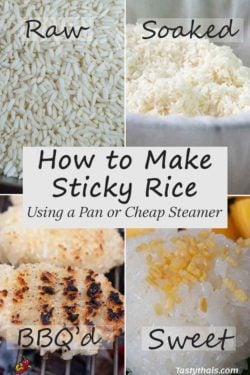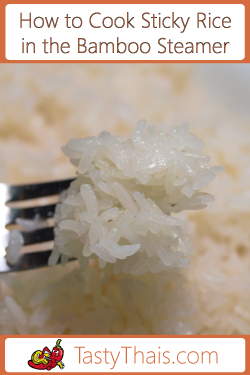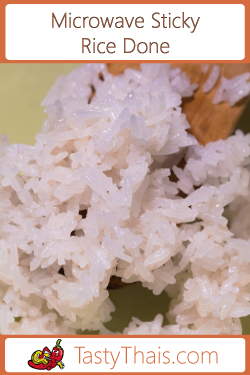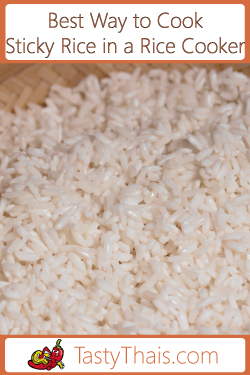Once you know how to make sticky rice in a saucepan you’ll have the confidence to make some great Thai recipes. In this post, you’ll learn how easy it is to make perfect sticky rice every time with just a saucepan or steamer.
Sticky rice is really versatile too as it suits both savory and sweet dishes as well as quick snacks and something different on the BBQ.
Sticky rice is the common term for Glutinous Rice which develops a sticky coat when cooked with the result that the grains stick together. Hence the name “Sticky Rice”.
Link to How to Cook Sticky Rice in a Saucepan Video in case it does not load for you.
Links disclosure: Some links on this page go to affiliate partners where, without cost to you, we may receive a commission if you make a purchase.
Super Popular Sticky Rice
Sticky rice is very popular all over Thailand but especially in the northeast where it is grown and is a favorite as it is easy to roll up with your fingers to eat after dipping in a super tasty sauce. Or you can use it to mop up any liquids left on your plate!
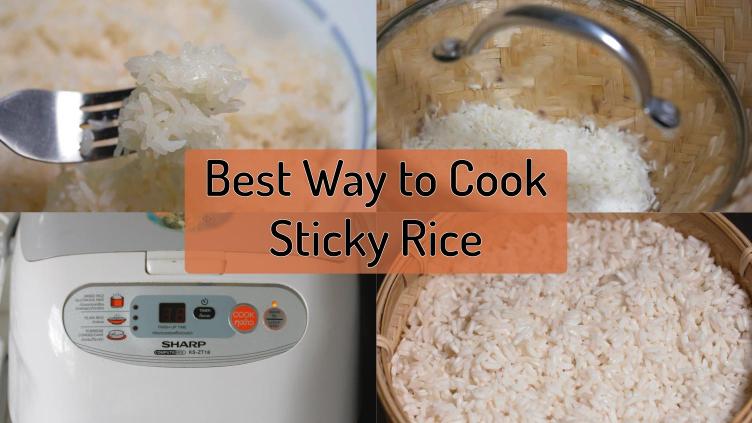
It is versatile too as it goes with savory dishes like Nam Tok Nua, which can be grilled on the BBQ for Khao Jee or for sweets and desserts like Mango with Sticky Rice.
There’s quite a lot of ways you can successfully cook sticky rice too. The traditional way uses a bamboo type steamer, then there is the suprisingly good way of cooking with the microwave, cooking in the rice cooker methods without an insert or better still with a steaming basket insert. Then there are the methods described in this post.
One way or another you’ll find a method that suits you and the equipment you have to hand.
The first few times you cook rice it is quite common to be disappointed at the outcome. Not everyone has a rice cooker. If you cook rice often though, it pays to get one as you can use it for more than just steaming rice.
Anyway in this post we will go over how to make perfect steamed sticky rice without a traditional bamboo steamer (method using traditional steamer here), rice cooker (method for cooking sticky rice in a rice cooker with basket insert here) or microwave (a great method here).
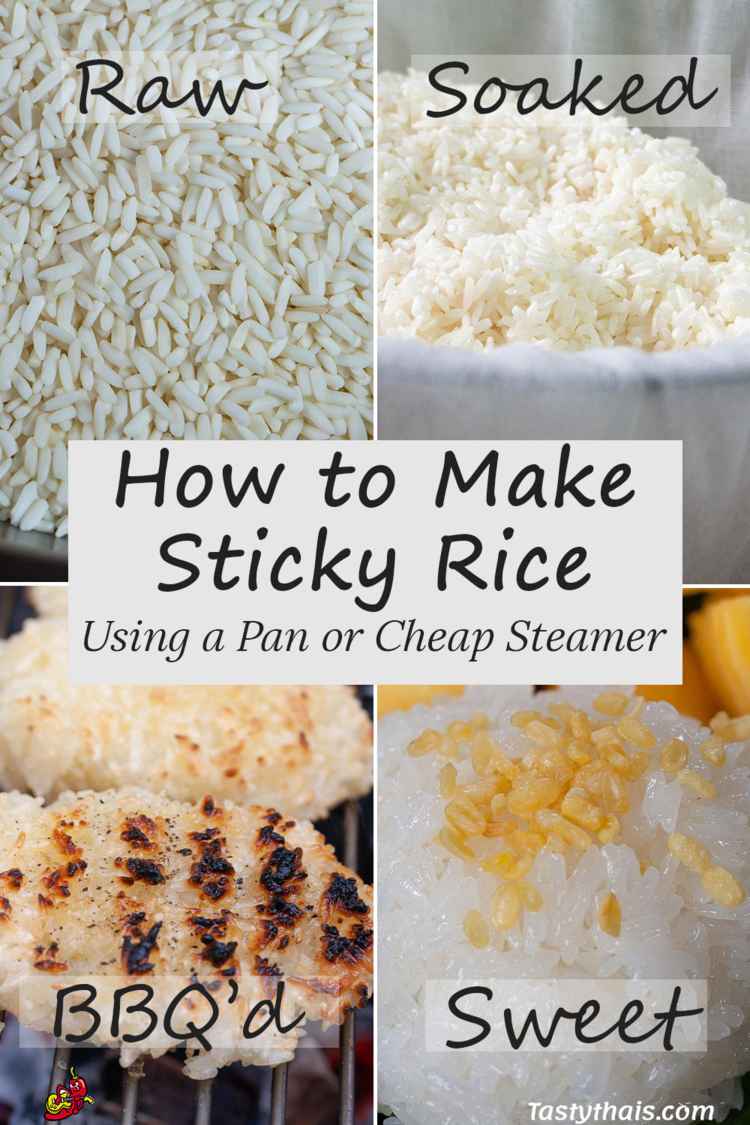
Equipment You’ll Need
If you have a simple steamer then you can use that or if not then you will need a saucepan and a perforated holder that can be suspended over the water within.
The cheap large-sized steamers are great for steaming fish and all manner of things and are a good value for money investment.
We have a cheap plastic steamer that we use for smaller quantities for cooking dim sum and other small steamed dishes as well as fillets of fish. It is multi-layered and quite versatile, easy to clean and great for steaming rice too if our rice cooker goes wrong.
We also have the large saucepan style steamer which is great for bigger quantities and for steaming larger whole fish for recipes like Steamed Whole Seabass with Lime and for cooking Hor Mok Pla Salmon in one go rather than batches.
Traditionally Thais use a bamboo steamer which is a porous upside-down hat-shaped porous holder and used mainly to steam rice.
But even if you haven’t got any of that equipment, you can just use your largest saucepan with a large sieve used to suspend the rice over the water in the saucepan.
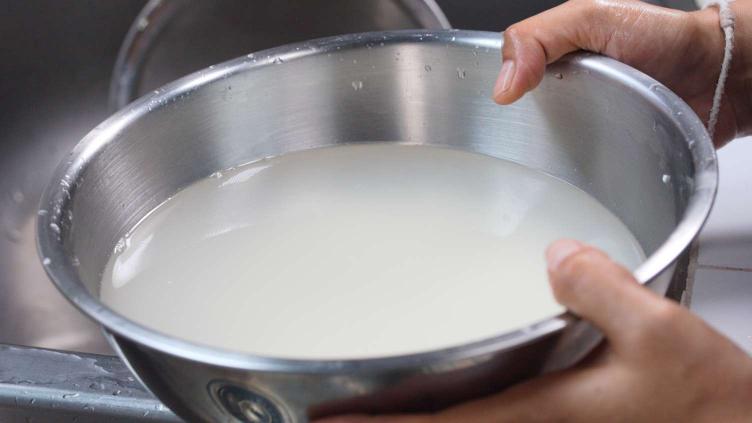
Cooking the Sticky Rice Step by Step
Step 1 Washing the Sticky Rice
Firstly you will need to ensure that you have the right kind of rice which is usually labeled glutinous rice. Bear in mind there are various varieties of glutinous rice with differing characteristics and also old and new crop rice to be had.
Most packaged rice sold is new crop rice although old crop rice can be found in some markets and widespread if you are in Asia. These are the cheaper types of sticky rice on sale.
Regardless of the particular variety, or crop, you should place the uncooked rice in a container and flush through thoroughly with clean water. You can use a sieve and use your fingers to move the rice about whilst running water through it.
Or you can use a bowl and wiggle the rice about to release the starch (which clouds the water) and change the water several times until clear.
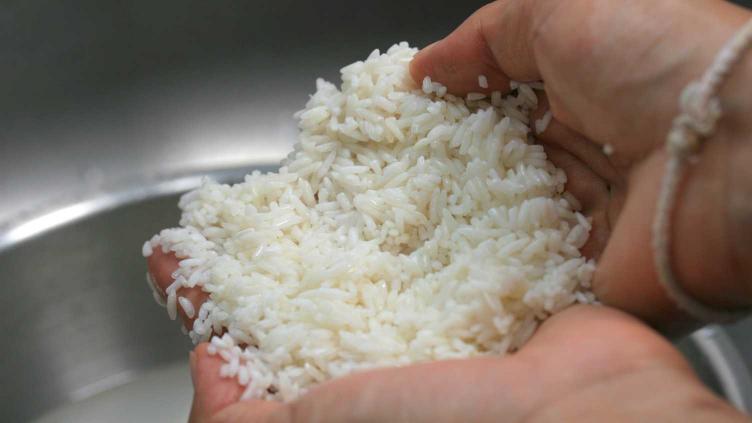
Step 2 Soaking the Glutinous Rice
Once washed place in a bowl for soaking and cover with water to a level about 1 inch (25mm) above the top of the rice. The most common new crop rice should soak for 2-3 hours during which the rice will swell a little.
If you know you have old crop rice then you will need to soak for 6-8 hours or overnight. If you are not sure which crop rice you have bought then assume it is new crop rice as that is the most common.
Step 3 Steaming the Sticky Rice
The basic method is the same whether you have an electric steamer or are using a saucepan with a suspended holder.
Line the bottom of the steaming tray or saucepan holder with a clean, dampened muslin cloth. This cloth will allow the steam to permeate and steam the rice whilst keeping it moist by trapping the steam and heat for more even cooking.
The muslin should be large enough to line the bottom of the pan and wrap over the top of the rice to form a sort of parcel.
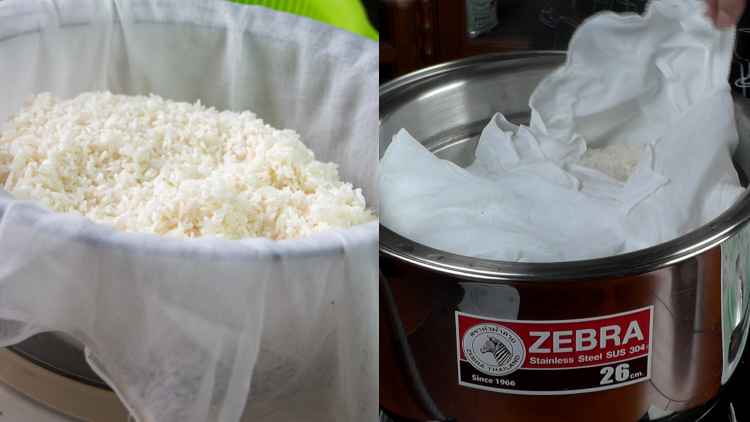
For the steamer method, fill your electric steamer to the manufacturer’s directions, Place the muslin covered rice in the tray and put the lid on. Set your steamer to steam for 20 minutes allowing an extra minute or two if it is slow to develop steam.
For the saucepan method, fill about 1/3rd full with water. Heat until the water boils and reduce heat to a simmer before placing the suspended perforated tray or sieve or other suspension device holding the muslin covered rice, on top.
Cover with a lid and steam for 20 minutes, setting a timer to remind you.
After 20 minutes is up, lift out the rice with the muslin and tip out onto a flat surface. Spread the rice out and fluff up to allow the excess steam to escape and place it into your serving bowls or individual bamboo containers and serve.
If you will be a little while before eating then cover your containers or bowls with a lid to help counter the rice drying out.
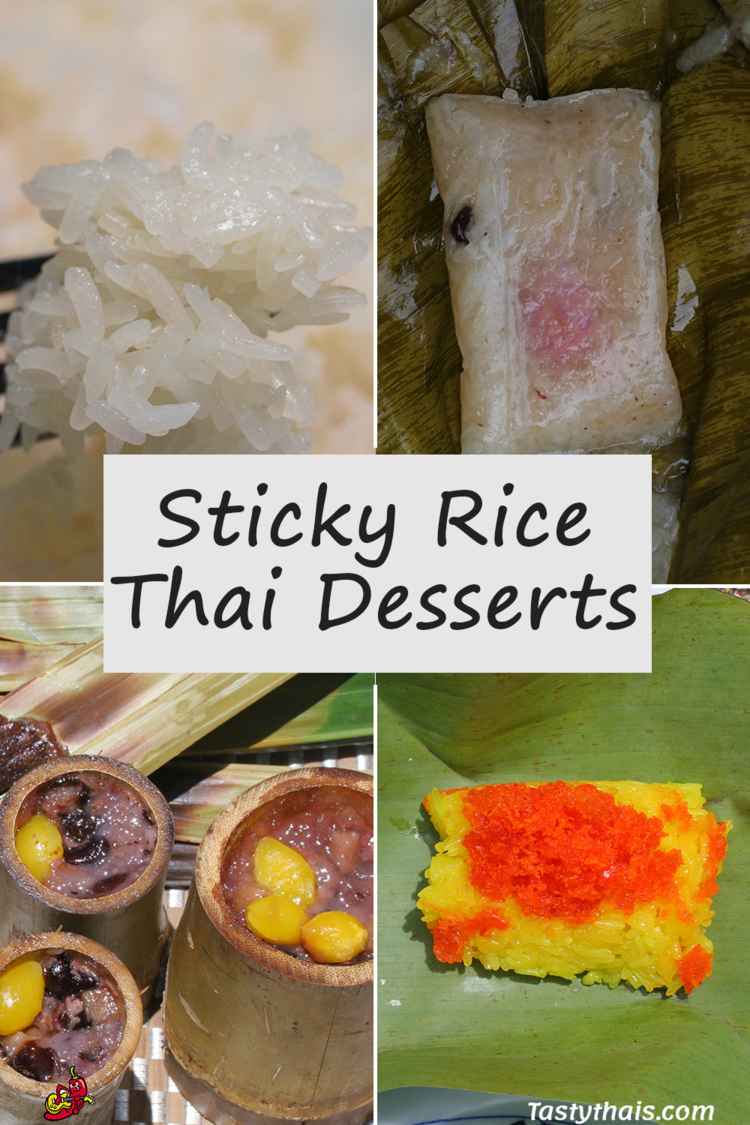
How to Make Sticky Rice with a Saucepan (or an Electric Steamer) Recipe
How to Make Sticky Rice with a Saucepan
The Video showing this recipe being cooked is near the top of the page – A convenient Jump Link to the video is below the description under here.
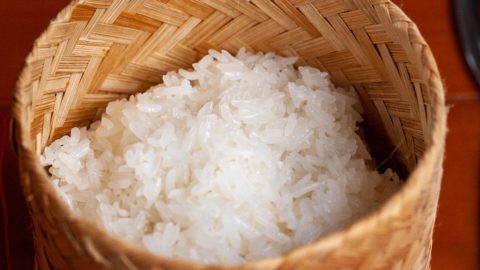
NOTE: Any In-recipe images can be toggled on and off with the camera icons next to the Instructions header.
Equipment
- Saucepan with sieve that can be suspended OR
- Electric Steamer
Ingredients
- 2 cups glutinous rice
- water
Instructions
- Ensure you have glutinous rice and not ordinary rice. There are white and black as well as brown rice varieties with teh colored varieties needing an extra hour in soak time. Wash the raw rice thoroughly under running water until the water runs clear.
- Put the washed rice into a bowl and cover with water to the top level of the rice plus about 1 inch (25mm)
- Soak for 2-3 hours for most glutinous rice on the market – 6-8 hours if you have intentioanlly bought old crop rice.
- Place a muslin cloth to line your electric steamer's tray or a sieve that will not slip into a large saucepan. Alternatively use a large saucepan that is made for steaming and line the inner trary with the muslin. The muslin should be arranged to allow the muslin to wrapped over the top of the rice before steaming.
- Place the soaked rice in the center and form a little crater in the midlle so that the mound of rice looks like a sort of flattened volcano. Cover over with the muslin.
- Add water to fill the saucepan to about 1/3rd and bring to the boil then reduce heat to a simmer. Place the sieve or other suspended container with the muslin and covered rice in the top of the saucepan so it sits well above the water level. Cover as best you can with the saucepan lid to mostly cover the top of the muslin covered rice.
- If using a steamer then add water to the level directed by the instructions and turn the timer to 20 minutes. Position the steaming tray and cover with a lid.
- After steaming for 20 minutes, use the muslin to lift out the cooked rice onto a flat surface. Agitate or fluff up the rice to release any trapped steam for a mnute or two.
- Transfer into your serving container and cover or place into individual bamboo servers and cover until ready to eat. If left uncovered then the rice will rapidy dry out and become hard so keep covered!
Nutrition

Planning on Making this Recipe?
It would be great if you could take a picture of your finished creation and share it out on Instagram. Tag me with #TASTYTHAIEATS – I love to see your ideas!
I really hope you enjoy this dish and if you cook it I would love to hear your comments below so please come back and let me know how it turned out for you.

I am a Thai mum and love cooking for my children. Over the years, I have taken my family recipes as well as ones borrowed from friends and adapted them to make them even tastier. I publish my authentic Thai Food Recipes here for all to enjoy around the world. When I get a chance to travel I publish information to help others visiting Thailand.
